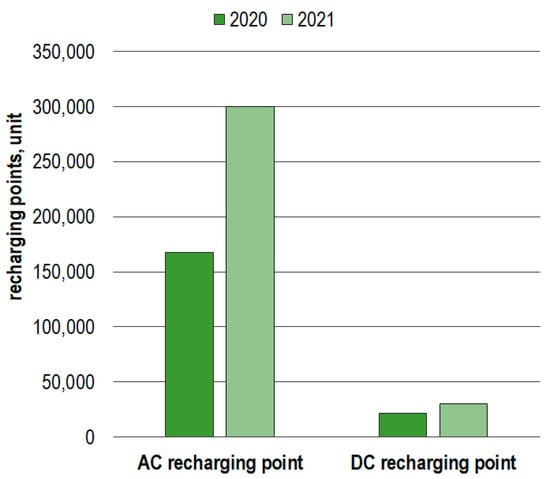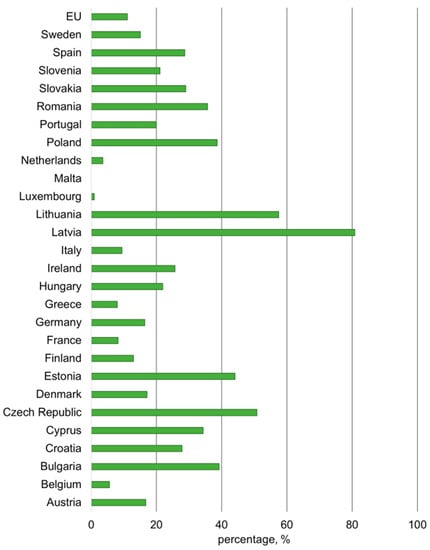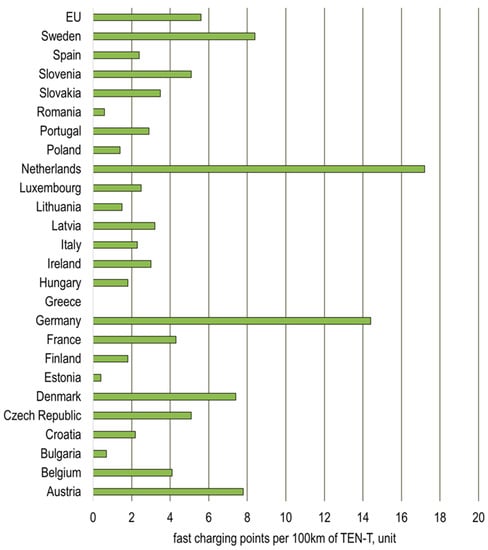Your browser does not fully support modern features. Please upgrade for a smoother experience.
Please note this is an old version of this entry, which may differ significantly from the current revision.
Subjects:
Transportation Science & Technology
Fast charging points are located within the public charging infrastructure, mainly along highways. In many regions the fast charging infrastructure for electric cars is still insufficiently developed. Due to the great economic diversity of EU countries, the development of charging infrastructure proceeds at different paces. For this reason, it is important to ensure that fast charging points are located primarily along the TEN-T network and highways.
- electric vehicle
- plug-in hybrid
- electric vehicle charging infrastructure
1. Introduction
Transport is the process of moving people, raw materials and goods from the place of origin to the place of destination. Road transport still has the largest share in the transport of goods and passengers. It was estimated that in 2020 the total freight turnover in the EU-27 amounted to 3272 billion tkm. Road transport accounted for 53% of this sum. In 2020, the total transport performance of passenger transport in the EU-27 using motor vehicles was 4446 billion pkm, i.e., the average distance per person was about 10,000 km. Passenger cars accounted for 80.6% of this number, while buses and coaches accounted for 6.6% [1].
Transport is also one of the most energy-intensive sectors of the EU economy. In 2020, the energy used for transporting materials and services accounted for 28.4% of the total energy used by the EU economy. Road transport is still almost entirely dependent on fossil fuels. About 95% of all road vehicles still use conventional fuels (diesel, petrol, compressed natural gas—CNG, liquefied petroleum gas—LPG). The development of the alternative fuels market is hindered, apart from higher vehicle purchase costs, by the lack of charging and refueling stations. In 2020, the total consumption of motor gasoline and diesel in transport amounted to 218,917.6 ktoe (ton of oil equivalent—a conventional standardized energy measure, based on a ton of oil with a calorific value of 41.868 kJ/kg) [1,2].
Between 1990 and 2018, total carbon dioxide emissions of the EU fell by 21.6%. Over that same period, emissions declined in all sectors except the transport sector, which saw a 21% increase in CO2 emissions [3,4]. Transport is responsible for around 20% of global greenhouse gas emissions, three-quarters of which are accounted for by road transport (76.7%) [5]. In the EU in 2020, the largest part of emissions was related to passenger mobility and came from passenger cars (59.5%) and buses (11.0%). The remaining 28.2% came from freight trucks [6].
The solution to reducing greenhouse gas emissions in road transport is to increase the number of low- and zero-emission vehicles powered by alternative fuels, such as electricity, hydrogen, biofuels or biogas. EU activities in the field of climate and transport policy are focused on promoting energy-efficient and ecological transport. Many automotive concerns have decided to develop new technologies in the field of electric and hydrogen drives. The idea of electromobility implies an increase in the importance of electric forms of both public and individual transport.
Currently, the electric vehicle market is boasting impressive growth. Thanks to the development of battery technology and the extending range, electric vehicles (EVs) are gaining more popularity. The main advantages of the electric drive are the low noise level and zero emission of harmful substances at the place of operation. Another advantage is the high efficiency of the electric drive. The main disadvantage of electric vehicles is their range. Electric vehicles on a single battery charge still have a shorter range than vehicles with combustion engines, gasoline or diesel [7,8]. The disadvantages of electric cars include the long battery charging process, much longer than refueling. This process is cumbersome for the user, especially during long journeys, as it involves the need to properly plan the route. The charging time of an electric vehicle battery depends on the following factors:
-
Energy capacity of the battery (measured in kWh);
-
Battery energy level (SOC—state of charge);
-
Technically available maximum vehicle battery charging power;
-
Technically available maximum power of the charging point—slow, fast and ultra-fast chargers;
-
Ambient temperature.
Many papers present an analysis of the efficiency and cost of ownership of electric vehicles [9,10,11]. Considerably fewer works are concerned with the analysis of electric vehicle battery charging infrastructure facilities. They mainly concern methods of planning and assessing the deployment of charging infrastructure in relation to current and future potential demand. These papers present optimization algorithms for the allocation of charging stations [12,13,14]. The process of planning the charging infrastructure mainly takes into account the EV users’ point of view regarding economic aspects or technical requirements of the power grid.
As shown in the works [15,16,17,18] the availability of public charging points is one of the key factors determining the willingness to purchase electric vehicles. The finding of the research presented in the paper [19] shows that the location and density of charging station networks are important aspects that can lead to greater acceptance of EVs and help overcome the phenomenon of range anxiety. As emphasized in the works [20,21] the location of EV charging stations should be comparable to the location of refueling stations with conventional fuels. Availability of public charging stations still needs to be improved in many regions and towns [22,23,24]. The EU takes action to stimulate the development of electric vehicle infrastructure. In its 2019 Green Deal for Europe, presented in 2019, the European Commission assumes an increase the number of charging stations and charging points for passenger cars and heavy-duty vehicles along the TEN-T trans-European road network.
A number of works provide an overview of electric vehicle charging infrastructure. Many of them present the technical requirements for charging points and the charging process itself. Many works also present the current state of charging station locations. Electric vehicles are already widely used mainly by city dwellers. In addition to daily city driving, electric vehicle users may also choose to travel further afield. Currently, charging an electric vehicle’s battery still takes several times longer than refueling a conventional vehicle. Charging with fast chargers can take 20 to 30 min. Traveling long distances in an electric car requires careful planning of the route, taking into account the available charging infrastructure and the time spent on charging. This prompted the author to investigate the current state of electric vehicle fast-charging stations along highways.
2. Electric Vehicle Charging Infrastructure in EU
Electric car users most often charge their batteries using home chargers. In 2021, 61% of electric vehicles were charged at home and 15% at the workplace. Around a quarter of electric vehicles in use in the EU were charged using public chargers [63]. In 2021, there was a marked increase in the number of public charging points for electric cars. As mentioned earlier, charging of EVs can take place via direct current (DC) and alternating current (AC) chargers (Figure 2) [44].

Figure 2. Public charging points by charging current.
Most public chargers in the EU use alternating current. They account for 90% of all public charging points. Compared to 2020, the number of public DC chargers increased by 44% and the number of public DC charging points increased by 30% (Figure 3) [44].

Figure 3. The share of fast and slow chargers at publicly accessible (a) AC charging points and (b) DC charging points.
Among the charging points with alternating current, the most available are chargers with an average speed of charging with three-phase current with a power range from 7.4 kW to 22 kW (Figure 3a). Their share of all publicly available charging points was 88% in 2020 and 83% in 2021, respectively. Fast chargers account for only around 3% of generally available AC charging points in the EU.
When analyzing publicly available DC charging points, fast chargers with a power range of 50 kW to 150 kW are the most numerous (Figure 3b). They account for half of the publicly available DC chargers. The number of ultra-fast DC chargers is growing. Due to the charging power, there are two types of ultra-fast chargers: level 1—with a power in the range of 150 kW to 350 kW, and level 2—with a charging power above 350 kW. Among all publicly available DC charging points, their share was 24% in 2020 and 35% in 2021, respectively.
Fast chargers allow an electric vehicle’s battery to be recharged in a short time span. The availability of fast charging points is particularly important for electric vehicle users travelling long distances. Fast chargers in 2021 accounted for 11% of all publicly available chargers in the EU (Figure 4).

Figure 4. Percentage share of fast chargers in public charging points in the EU, by country.
In Latvia, 81% of all public charging points have fast chargers. In Lithuania, the share of fast charging points in the overall public charging infrastructure is 60%. In the Czech Republic, half of the charging points offer the possibility of fast charging. The lowest share of fast charging points (less than 10%) in the entire charging infrastructure is recorded in Malta, Luxembourg, the Netherlands, Belgium, France, Italy and Greece.
One of the indicators showing the availability of public charging points for electric vehicle users is the number of charging points per 100 km of roads (Figure 5). The largest number of public charging points for electric cars per 100 km of roads are in the Netherlands (48 charging points) and in Luxembourg (35 charging points). In Germany, there are 20 public charging points per 100 km of road. In 13 EU Member States, there are less than 2 public charging points per 100 km of road [64].

Figure 5. Number of charging points for every 100 km of 100 km roads in EU, by country.
Another indicator of the availability of charging infrastructure for electric vehicles is the ratio of the number of charging points per 100 km of roads within the TEN-T network. Trans-European Network-Transport (TEN-T) is a trans-European road network that was established by a decision of the European Parliament and the Council on 23 July 1996 [65]. The current TEN-T policy is based on Regulation 1315/2013 of the European Parliament and of the Council [66]. The TEN-T network is part of the Trans-European Networks (TEN) program, which assumes the development of road, rail, water and air transport corridors in the European Union countries, facilitating and accelerating the transport of goods and greater mobility of passengers. An effectively functioning transport system within the EU contributes to the improvement of the functioning of the single internal market, stimulates the economic growth of the region, and increases the competitiveness of individual member states and the entire EU on a global scale. The TEN-T network is constantly being developed, modernized and adapted to the appropriate infrastructure. Green Deal for Europe places particular emphasis on the development of infrastructure for alternative vehicles. Figure 6 shows the number of fast combined charging system (CCS) chargers for every 100 km of TEN-T network in European Union countries [45].

Figure 6. Number of fast combined charging system (CCS) chargers for every 100 km of TEN-T network in EU in 2020, by country.
On average, there are five publicly available fast charging points for electric vehicles per 100 km of the TEN-T network in the EU. The largest number of publicly available fast chargers can be found along the TEN-T routes in the Netherlands and Germany, respectively, with 17 and 14 charging points per 100 km of the TEN-T network. In eight EU Member States, there are less than two fast charging stations per 100 km of the TEN-T network. In Romania, Bulgaria, Estonia and Greece, there is not even one fast charging point per 100 km of the TEN-T route.
This entry is adapted from the peer-reviewed paper 10.3390/en16020895
This entry is offline, you can click here to edit this entry!
